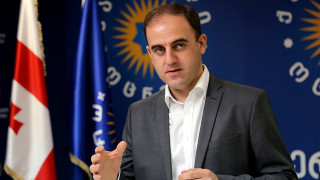On 11 April 2014, the former Minister of Regional Development and Infrastructure of Georgia, Davit Narmania (current Tbilisi mayoral candidate), presented a report on activities implemented in 2013 at his final briefing as Minister. According to Narmania, 260 km of roads were rehabilitated in 2013 which represents 60 km more than was done in 2012. He also indicated that 45 bridges and five tunnels were rehabilitated in 2013 while only 28 bridges and two tunnels received rehabilitation work in 2012.
Narmania also spoke about the Village Support Programme and regional infrastructural projects implemented as a part of the Regional Development Programme. According to his statement, the total cost of the projects that were carried out in 2013 within the framework of the abovementioned programmes comprised more than GEL 270 million and is an amount which is unprecedented if compared to the previous years. As Narmania put it, different from the previous years the greatest amount of money was spent on infrastructural projects in 2013. As many as 8,000 small and medium sized infrastructural projects were carried out overall.
FactCheck took interest in the abovementioned statement and inquired about its accuracy.
FactCheck contacted the Roads Department of Georgia for information related to road infrastructure. In response to our inquiry the Department reported that the state budget funded the rehabilitation of 117 infrastructure items in 2013. The total length of rehabilitated roads comprised 190.3 km. The 2013 state budget allocated GEL 214,093,000 for the reconstruction and rehabilitation of roads. The factual cash expenditure was GEL 195,193,280 comprising 91.17% of the initial plan.
In 2012 the state budget funded the rehabilitation of 82 infrastructure items with the total length of rehabilitated roads comprising 108.9 km. For repairing and rehabilitating road sections, the state allocated a total of GEL 128,615,000 in 2012. The factual cash expenditure covered GEL 117,085,260 comprising 91.04% of the initial plan. The detailed list of rehabilitated road sections of 2012-2013 is available at the following links (Road Rehabilitation 2013, Road Rehabilitation 2012).
FactCheck also got in touch with the Municipal Development Fund of Georgia. According to the information provided to us, the Fund rehabilitated up to 7.76 km of road sections in 2012 with the assistance of the state budget that comprised a total of GEL 1.5 million overall. As for the data of 2012, the state budget provided a total of GEL 6.7 million for the rehabilitation of road sections amounting to a total length of 11.8 km.
FactCheck also researched the issue of rehabilitated bridges and tunnels in 2012-2013. Based upon the information obtained from the Ministry of Regional Development and Infrastructure of Georgia, a total of 45 bridges and three tunnels were rehabilitated and nine new bridges were constructed in 2013 in accordance with the plan. As for 2012, these numbers comprised 28, two and three, respectively.
FactCheck also investigated the second part of Davit Narmania’s abovementioned statement regarding the Village Support Programme and regional projects. Based upon the Report on the Accomplishment of the State Budget of Georgia 2013, the state allocated a total of GEL 49,993,800 for self-governing units within the framework of the Village Support Programme in 2013. Upon the request of self-governing units, GEL 49,723.900 from this amount were transferred to the municipal units.
A total of GEL 307,296,600 was allocated for infrastructural projects in 2013. The municipalities received GEL 233,122,300 from this amount based upon the request of self-governing units. According to the Report on the Accomplishment of the State Budget of Georgia 2013, the overall expenditures for the Village Support Programme and Regional Development Programme infrastructural projects comprised GEL 282,846,200.
FactCheck also took interest in the respective data of 2012. The Report on the Accomplishment of the State Budget of Georgia 2012 contains information on both the Village Support Programme and the Regional Development Programme. According to this report, the state allocated a total of GEL 50,000,000 for the Village Support Programme in 2012. The local municipalities were provided GEL 49,910,400 from this amount upon the request of self-governing units. As for the implementation of regional infrastructural projects, the state allocated GEL 298,571,200 for these purposes in 2012 while local municipalities received GEL 296,671,100 from this amount upon the request of self-governing units.
According to the Report on the Accomplishment of the State Budget of Georgia 2012, the total amount spent on the Village Support Programme and regional infrastructural projects implemented under the Regional Development Programme comprised GEL 346,581,100.
Of further note is the fact that FactCheck acquired no information about the actual cash expenditures of the municipal units for infrastructural projects at this stage.
Davit Narmania also spoke about the construction of the express highways as well as all the infrastructural projects implemented in 2013 at his final briefing. FactCheck already inquired about these issues in the past and confirmed the accuracy of Narmania’s statement.
Conclusion
The information of the Roads Department of Georgia showed that 190.3 km of road sections were rehabilitated in 2013 while this number equalled 108.9 km in 2012. Therefore, the length of repaired road sections is 81 km more than in the previous year. Road rehabilitation was also done by the Municipal Development Fund of Georgia: 7.76 km of road section repairs were paid for by the Fund in 2013 while 11.8 km of road repairs were funded in 2012. The total length of rehabilitated road sections in 2013 did not amount to 260 km as reported by Davit Narmania. As for the bridges and tunnels, Narmania’s statement is accurate.
The second part of Narmania’s statement, however cannot be regarded as accurate since the total cost of the projects implemented within the Village Support Programme and the Regional Development Programme consisted of GEL 282,846,200 and which in fact is not the highest indicator observed within these programmes. The state allocated a total of GEL 346,581,100 for both of the abovementioned programmes in 2012.
Therefore, FactCheck concludes that Davit Narmania’s statement is HALF TRUE.
Originally published in The Financial, issue N. 23 (403)








